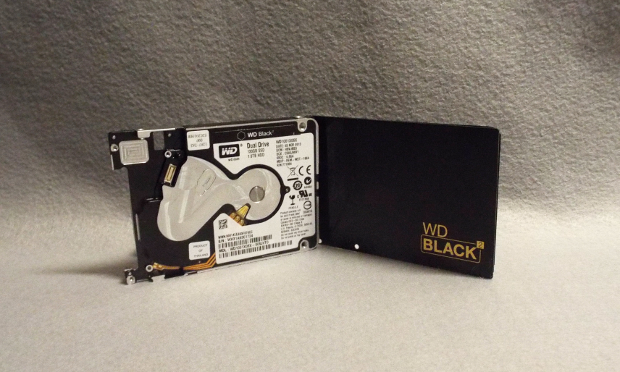REPORT ANALYSIS AND FINAL THOUGHTS
The performance of the WD Black2 Dual Drive is a bit of a good news / so-so news situation. Boot speeds are truly SSD-fast. Read performance with compressible data was very strong, and in many of our benchmarks the dual drive handled compressible and incompressible data equally well. Write speeds being “capped” at a maximum of 145-147 MB/s, no matter the situation, was a bit disappointing. This could be a limitation of being paired with an HDD that has to occasionally be written to. A PCMark Vantage HDD suite score of over 57,000 was a pleasant surprise, especially the fact that it was a 28% increase over the SSD by itself. Both the SSD alone and the Dual Drive setup exceed WD’s stated sequential read and write speeds of 350 MB/s and 140 MB/s, respectively.
The other sticking point I have about the WD Black2 Dual Drive is WD’s asking price. Granted, once on the market for a bit prices tend to edge downward, but $300 as a starting point may limit its appeal. The standard argument we are going to here will be something to the effect of “But I can readily buy a 128GB SATA III SSD and 1TB HDD, both being models with superior performance to the Black2, and have a few dollars left over.”
In WD’s defense, we cannot fit the two separate drives into a laptop or notebook with a single drive bay. We also are not receiving a free Acronis TrueImage download or a USB-to-SATA adapter cable for cloning purposes, nor are we receiving the proprietary partition management software for the price of the two individual drives.
I can perceive value when I look at what all is included, but the average potential customer may not be willing to look at it more closely if the $300 price of admission scares them off. If WD can figure out how to get the Black2 Dual Drive down below $250, preferably at the MSRP level before any discounting comes into play, the consumer appeal would go up dramatically.
The WD Black2 Dual Drive is a bit of an enigma. The potential market that WD is keying this product to is laptops / notebooks with a single 2.5″ drive bay. The product itself appears to be either a successful implementation of new technology; or a successful implementation of a different approach to existing technology. It would seem more than a bit limiting to bring to market something that has potential magnitude to it, and only offer it to a rather narrow market. Does WD have other such implementations on its drawing board?
All in all, the WD Black2 Dual Drive is a very interesting storage product, and is certainly worthy of our Innovation Award!
 The SSD Review The Worlds Dedicated SSD Education and Review Resource |
The SSD Review The Worlds Dedicated SSD Education and Review Resource | 


I’m no much of a laptop person and i think it wont do me any good since i use mine for work(not on desk) and its constantly moving, and hdds parts are kind a risky, so 100% SSDs for laptops or any mobile device. But i wike to see bigger HDD for work at home ! Very helpful review !
the NAND is known to be 20nm but you don’t know the vendor? how is that? technically Sandisk and Tosh do not have 20nm process.
The memory is not marked and the manufacturer didn’t provide the information at the time of the report. We don’t guess.
I bought one of these and have installed it with programs on SSD and data on the 1TB HDD.
I find the 1TB HDD slow to respond to document opening etc. I would have preferred a 7,200 rpm HDD connected to the SSD
Being a pure SSD lover, I can’t say as I blame you.
Love this product… Installed it 6 months ago and it made my 3 year old laptop respond faster than my friends 2015 gaming laptops (with sshd in it). Money well spent.